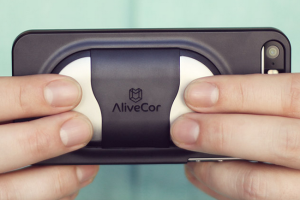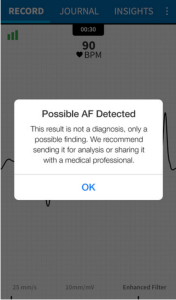Got your attention? I find there’s nothing like the fear of death to focus one’s attention.

AliveCor
Somehow I managed to forget blogging about one of the real highlights of last Spring’s RE-WORK Connect Summit here in Boston: the AliveCor Mobile ECG.*
Perhaps the most important thing about the Mobile ECG is that it is not just a helpful Quantified Self fitness device, but has past the rigors of the FDA licensing process, building both users’ and docs’ confidence in its reliability as a diagnostic tool, and also underscoring that IoT devices can be significant parts of mobile health strategies. As Dr. Albert said to Forbes, ““No one cares whether their Fitbit is accurate or not …. A point of here or there. With ECGs, that’s different.” In 2015 the FDA also approved an algorithm instantly letting you know if your reading was normal.
Because of the FDA approval, I put the Alive ECG in that special category of IoT devices and services that are important both in their own right and because of their symbolic role, especially when they meet my test of the IoT allowing “what can you do that you couldn’t do before,” in this case, a self-administered device that isn’t just generally informative about your fitness level, but also gives reliable medical documentation (especially since this allows that documentation to come as part of your activities of daily living, not requiring you to be in the artificial setting of a doctor’s office or hospital).
I see it as a critical tool in my “Smart Aging” paradigm.
Atrial fibrillation (a common abnormal heart rhythm), the condition the ECG documents, is a huge, and growing, problem. The latest figures I could find, from four years ago, show that people who suffer from it are hospitalized twice as frequently as those who don’t have it, and the annual costs in the US alone are $26 billion.
I found the price on Froogle as low as $86 for one to fit a 5s. Sweeeet!
Here’s how it works. The AliveCor is always available when you suspect you may have a heart problem, because it’s your smart-phone’s case! How brilliant is that? You just rest the two metal pads on your fingers or chest to record an ECG in 30 seconds.
AliveCor has recently beefed up its app by adding the “Heart Journal.” After each reading, you just tap on a Symptom, Activity or Diet tag to add it to your recording, or, like a lot of Quantified Self apps, you can also add in notes between readings about possible indicators such as what you’re eating or your activities. The Beat Fluctuation feature lets you see how your heartbeat changes from beat to beat.
I couldn’t help but think how the AliveCor would have helped me last Winter, when Boston endured the 1-in-26,315-years-Winter-From-Hell (nope: no typo!) . Like everyone else, I was perilously perched on my ladder, 20′ high, sticking my left hand through the ladder to pound away at an ice dam to my right with a REALLY heavy sledge hammer. Unlike many others doing the same thing, I’m old enough (ahem..) that this counted as Risky Business. After several hours, I started to feel chest pain. Two days and many heart tests later, I emerged from the hospital with my own diagnosis confirmed: just a muscle strain caused by the weird position of my hammering. Couldn’t help thinking that if I’d had an AliveCor on my phone, I could have just whipped it out, taken a reading while on the ladder, and, as the web site sez,” AliveCor’s FDA-cleared Normal Detector will determine right away when your ECG is normal,” and gone back to chipping away!
Loved this quote about the AliveCor’s significance:
“Just as the introduction of thermometers and blood pressure cuffs in the past century helped patients to monitor their health, now the ability to record one’s own electrocardiogram – and get an interpretation instantly – empowers the 21st century patient to take charge of their heart health.” –Ronald Karlsberg, MD Clinical Professor of Medicine, Cedars-Sinai Heart Institute
*in my defense, I was mesmerized by AliveCor founder Dr. David Albert’s colorful bowties….




